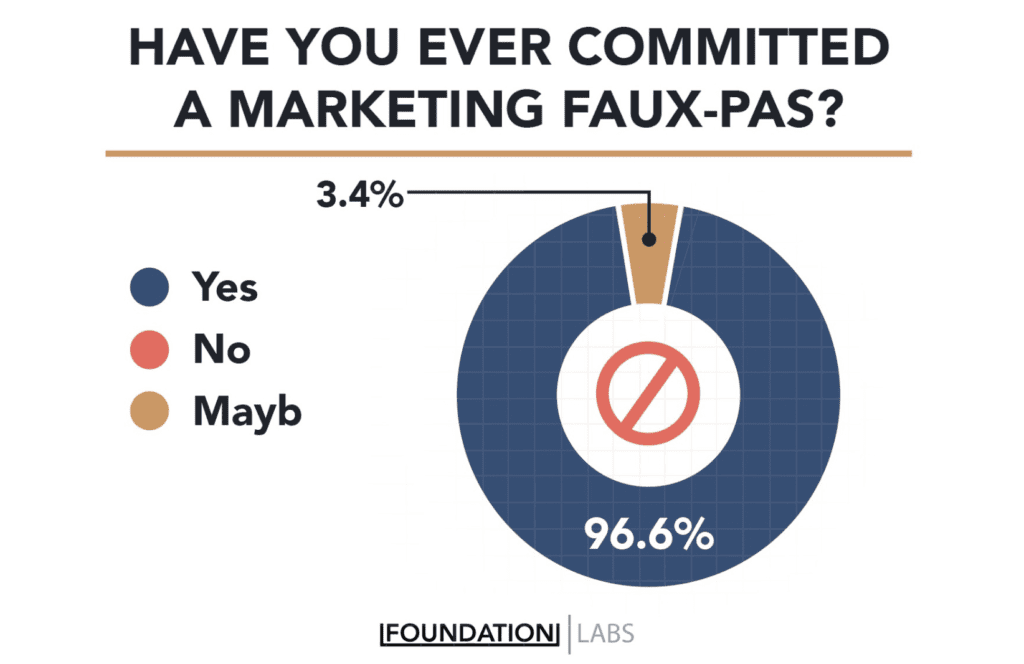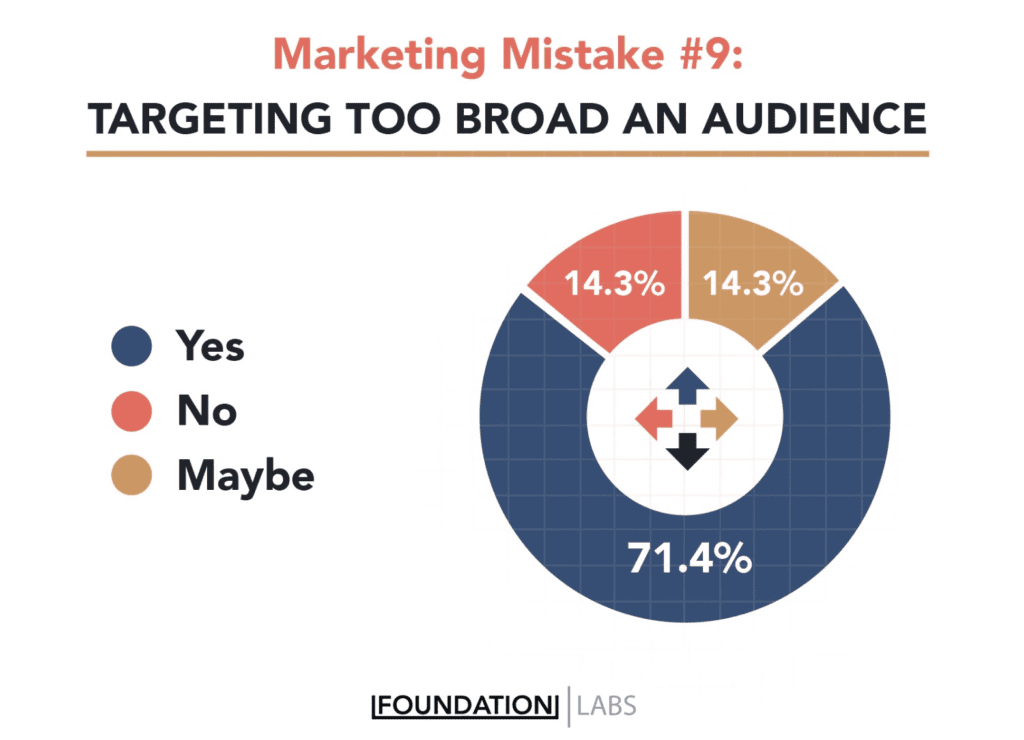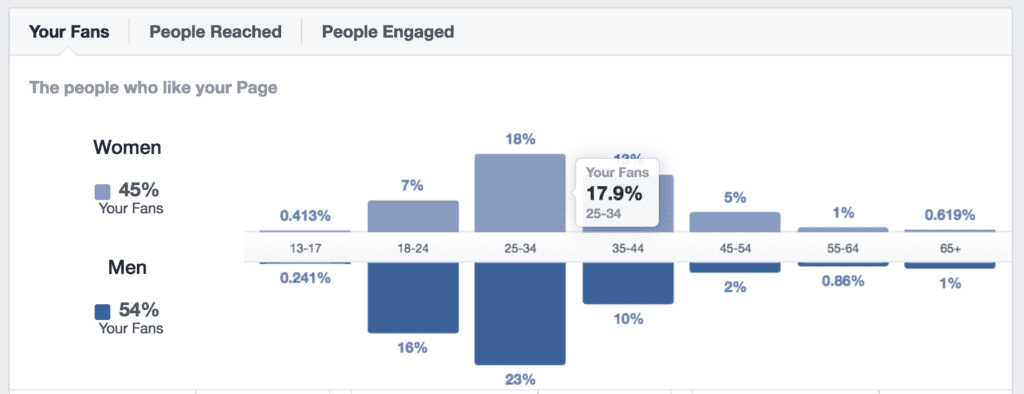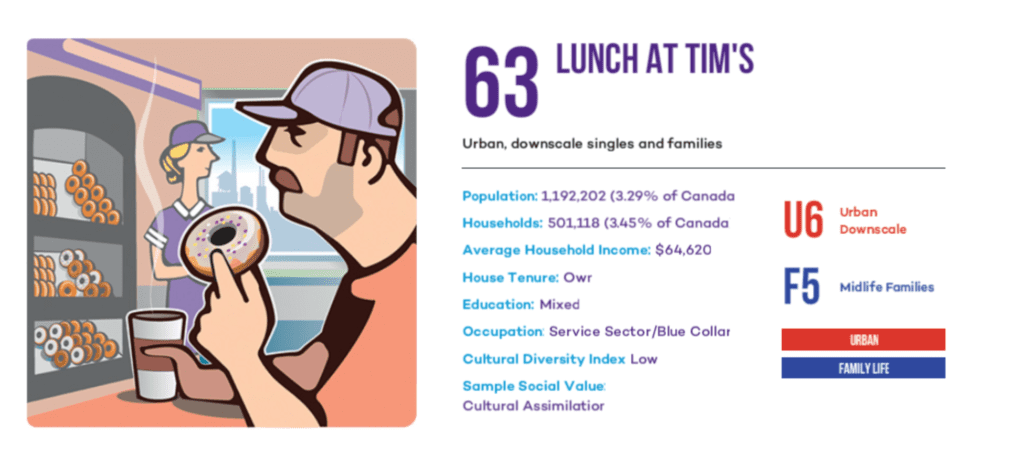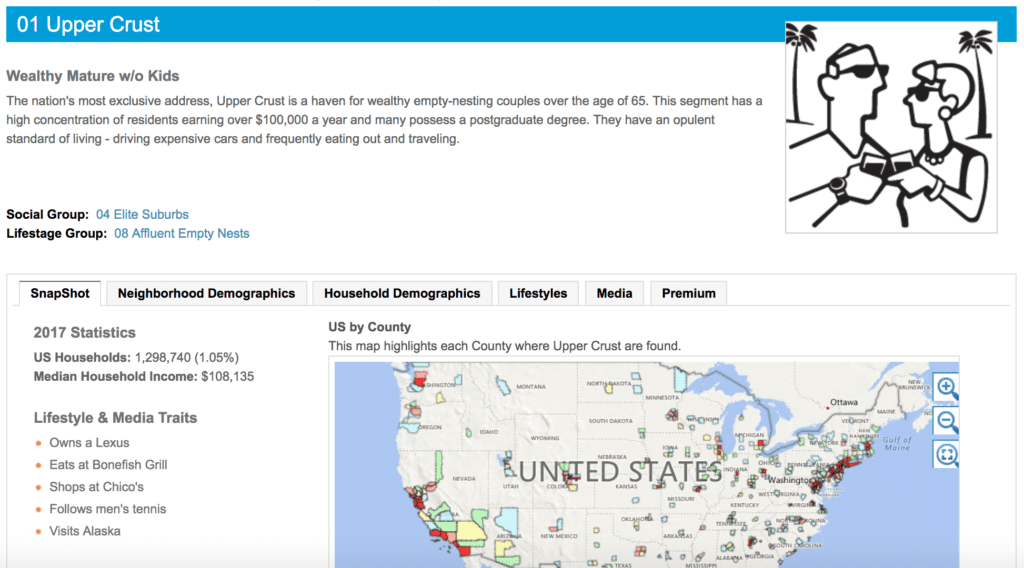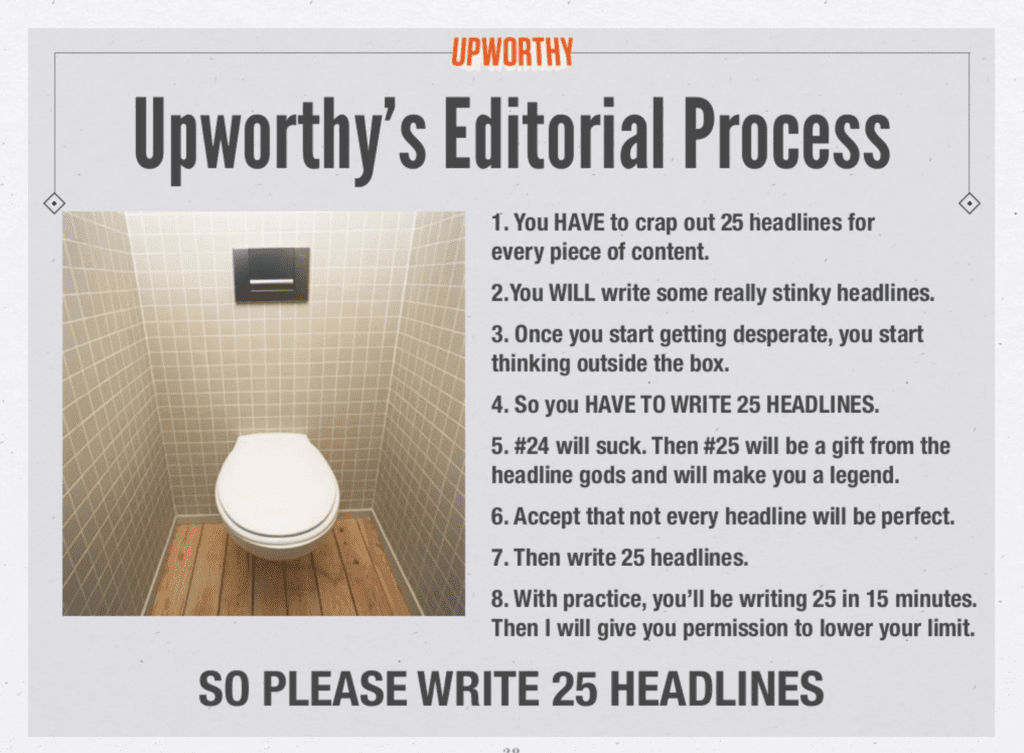Everyone, and I do mean everyone, will make a content marketing mistake at some point in their career.
In fact, in a study conducted by Foundation, researchers asked a group of marketers if they had ever made a mistake / marketing faux-pas and a staggering 97% said yes…
During my MozCon talk about content chaos, I talked about how I failed the first time I tried to use Reddit as a content marketing channel. In my presentation, I talked about how I assumed that you could go onto this channel, submit a handful of content and drive traffic. Well…
What happened?
I was blocked.
I was banned.
I was devastated.
But I was able to learn from this MASSIVE Content Marketing Mistake.
I spent time understanding Reddit, joined a bunch of the best Subreddits for Marketers and eventually I was able to land on the front page (multiple times), close new business through Reddit DMs and repeat success over and over again.
Don’t get me wrong:
Content marketing mistakes are something we can embrace.
As long as we use our mistakes to learn what doesn’t work.
However, you also have to get real with yourself and your business, and recognize that these mistakes are unacceptable if they are made over and over and over again. Some mistakes can be costly. And unfortunately, every single week, I come across marketers from around the world making mistakes with their approach to content marketing.
Here are six of the biggest content marketing mistakes that marketers are continuously making time and time again. In this post, I’m not just going to share the mistake but I’m also going to share with you an in-depth look at how you can avoid them and a special cheat sheet that I’ve used to help ensure that my metrics don’t pause faster than a mannequin challenge.
Let’s get to it…
Mistake 1: Thinking You Know Your Audience Instead Of TRULY Knowing Your Audience
When I first started working in the world of advertising, I was surprised how many agencies relied on their own experience to determine their “target audience.” Very rarely did the marketers I was coming into contact with want to rely on actual research or data to determine their target audience.
It felt wrong.
Creating quality content that resonates with your target audience starts with knowing your target audience. It’s not good enough to assume that research conducted 8 years ago is still relevant today. Instead, you need to take the time to gather both qualitative and quantitative data to understand your target audience.
Here are a few things brands can do to truly understand their audience:
Use Google & Facebook Analytics To Find Insight
If your company or brand has been around for a while, it’s likely that you’re sitting on a handful of quality data to help you understand your audience. A combination of Google Analytics & Facebook Analytics can be a marketer’s best friend when it comes to identifying your target audience.
One of the best parts of Google Analytics is the ability to know what content you’re developing that is resonating with people. Take a look at the content you’ve published over the last few years and analyze what content has done well and what content has fallen flat.
When using Facebook Analytics, the first thing I like to check out is the People Insights to see the age range we’re attracting on Facebook:
This is a great starting point but it’s really just that. You can also use Facebook Analytics to learn where your audience lives geographically. From there, you can take a closer look at what life is like in these areas using a tool called PRIZM.
Use PRIZM To Better Understand People Based on Location
This is one of my favorite tools for identifying a target audience. PRIZM is a tool from Environics Analytics that uses location data to create stories surrounding the people who live in that specific location. In Canada, it offers you the ability to type in a Postal Code and within seconds retrieve insight into the people who live in that area.
Here’s an example of what you’ll get from a few Canadian postal codes:
Of course, it’s not always 100% accurate and doesn’t represent every single individual from an area – but from what I’ve seen, it’s pretty good at representing the average resident.
American?
Don’t worry neighbor. I’ve got you covered.
The folks at Nielsen/Claritas have created a tool that offers a similar service. In the example below, I simply typed in the only postal code I know from memory (90210) and it spit back results showing income, household composition, population age and qualitative groups. This area in particular was deemed to be the Upper Crusts:
Conduct Surveys With Existing Customers
The best way to learn about your customers is to talk to your customers.
After looking at the quantitative research through things like Keyword Planner or your own Google Analytics, I like to get insight direct from the customers. A short customer satisfaction survey that asks questions about their media habits, current challenges, individual interests and psychographics is a great way to learn what type of content will resonate with your target audience.
Mass surveys is one of the most effective ways to learn from your customers. I recommend using survey tools like Typeform or SurveyMonkey to develop a survey and distribute it directly through a mailing list. If you’re able to incentivize your customers to filling the survey with a prize, even better. I’ve seen simple swag offers increase opt-in rates for surveys by up to 80%.
Google Keyword Planner
I like to use Google’s free Keyword Planner to get started with understanding what people are looking for when it comes to a specific topic. It’s a great resource for early stages of research as it helps you understand what keywords people are using to find your solution and offer some inspiration around the type of stories that could also be relevant to this target audience.
SparkToro
SparkToro is another innovative research tool that I find incredibly useful for understanding audiences in a more nuanced way. It goes beyond the basic keyword search and delves into the social and web behavior of your target market. By analyzing millions of social media profiles and web pages, SparkToro can provide insights into what your audience reads, watches, listens to, and follows.
This kind of data is invaluable for content creators looking to tailor their messages or find promotional channels that will resonate most with their intended audience. Whether you’re crafting a content strategy, planning social media campaigns, or looking for influencers who genuinely align with your brand’s values and audience interests, SparkToro offers a wealth of information that can help refine your approach and ensure that your content reaches the right people at the right time.
Mistake 2: Launching Too Many Albums And Not Enough Mixtapes
What does that mean?
It means instead of always rushing to force people to give an email to access your best content, offer some of your greatest hits for free. If you’re not familiar with one of the biggest rappers in Hip Hop, Drake, let me start by saying he’s at the top of the industry. Second, I want to point out the fact that he didn’t always find himself in this position – it started with mixtapes. Free albums that he put his heart and soul into with the hope that people would resonate with the music.
And it worked…
In marketing, you need to think about every free piece of content you develop and share with the world to be a mixtape. Every podcast interview you agree to do, that’s a mixtape. Every video series you develop that is filled with valuable information for your audience – that’s a mixtape.
In recent months, it feels like everything worth reading requires an email address. The best marketers recognize that the best way to get someone to buy your album is to give them value first. Take for example, the folks at SumoMe and their constant flow of valuable information on their blog. The team creates and publishes in-depth articles that rival the content most marketers hide behind paywalls or lead magnets.
It’s their competitive advantage.
Give IMMENSE value to your audience FOR FREE and they will take notice.
Take a look at this comment on one of their blogs:
That’s the type of comment every blogger wants.
You want people to see you as a brand that is constantly delivering valuable content. It can be content that informs them, inspires them, entertains them or simply gets people talking. At the end of the day, the goal is to create content so good that it makes people want to keep coming back for more because they know they can rely on you to delivery value.
Mistake 3: Trying To Replicate The Voice & Success Of Other Brands
The one thing you can never do wrong? Being yourself.
It might sound corny but it’s true.
The most important thing in the world is knowing who you are as a brand or individual and letting that shine through your work.
Your brand ideas, your tone and your style all play a key role here. The mistakes we make the most are the ones where we imitate instead of initiate. Sharon Haver, founder of @FocusOnStyle says it this way:
“The best brand you can create is an honest, polished version of yourself.”
And she’s right.
When you’re telling your own story, or the story of your brands, the only thing you can be perfectly is yourself. What do I mean by stay true to yourself? Think about the brands you know and love.
Older brands, like Apple and Adidas, have stayed completely true to their identity throughout the years. Adidas has always positioned itself as young, hip, and urban. Ironically, the suburban appeal with youth stems from the fact that it is all about the urbane. The message is clear: young, athletic, free thinking, and city-based is cool. And that’s what Adidas is about.
Another brand that has avoided this marketing mistake is, of course, Apple. Apple has positioned itself in the market as innovative, cutting edge technological solutions for every day folks. It has kept to its simple and beautiful design, and has surpassed its clunkier and less streamlined competitors. As a result of this, Apple has become synonymous with new technology and great gadgetry design.
All of this has been achieved by staying true to its identity.
Write down what you want to represent. Write down the way you want to be perceived. Once you have a clear idea of what you want your story to look like, be committed to taking steps, day in and day out, to make that story come to life.
Mistake 4: Refusing To Embrace Marketing Automation
Refusing to embrace marketing automation could be holding you back.
If you don’t want your growth to freeze like the mannequin challenge, invest time in learning and implementing a few automation systems for your brand. Automating at least some marketing activities can save you time from doing tasks that were once being tackled manually or help you do high value tasks that you’ve been avoiding.
One of the first things that I would recommend automating is some of your email marketing efforts.
If 1,000 people download an ebook that you’ve launched, it’s going to take hours to reach out to each of these people manually. Using email automation, you can send them an automated check-in 2 days after they download the guide and another 4 days later with a new resource.
The best part?
You don’t have to lift a finger after it’s been set up.
Lots of small businesses & early stage startups avoid marketing automation because they don’t think it’s authentic or they’re afraid of the cost. In both of these cases, I always put it this way:
It depends.
Automating direct messages as soon as someone follows you can feel inauthentic. Especially if it’s an attempt to come of as personal and you’re asking them to join your newsletter (trust me, I’ve seen it).
But automation on Twitter can work to your advantage!
One tool that I’ve recently found interesting is Socedo, it’s a B2B prospecting app that leverages twitter conversations to find leads. For example, you can select Real Estate Professionals and the app will set out to find these individuals, interact with them on your behalf and start a conversation with these prospects if they decide to follow you back.
One of the best examples I saw of a brand using Socedo was Tara Reed from Kollecto. Kollecto is a site for people who are interested in art and she used Socedo to find people who would be interested in this product. Socedo goes out and finds a bunch of people tweeting about art like this:
Went to an art museum today, it was lit pic.twitter.com/olggOkWhTK
— Killa✨ (@byefelicia17) July 15, 2016
And once the app identified these people it would automatically:
- Follow the lead
- Add them to an “Art Lovers” list on the Kollecto account
- Like their tweet (24 hours later)
- Send the person a DM letting them know about the app
Brilliant right?
The result:
They went from 1,000 monthly visits to 10,000 monthly visits.
Exactly.
Mistake 5: Writing One Headline For Your Content & Running With It
One of the most underrated tricks for giving your content a better chance of life is Headline Swapping. Headline Swapping is a technique being used by brands like Slate.com to generate millions of visits and thousands of shares, every single month.
It’s the act of writing multiple headlines for one blog post and using them in different channels. Here’s an example of Slate using Headline Swapping in the wild:
As you can see, the headline used on Facebook, the actual site and what shows up in Google are all different. The insight that Slate understands is that the way people find content on Facebook is very different from the way people find content on Google.
People are more likely to go to Google looking for Lady Gaga’s album review than they are to a network like Facebook. At the same time, they’re more likely to be distracted by the engaging headline about the Woman behind the meat dress on Facebook than an Album Review. Understanding your audience and how they behave on different channels is what leads to insights like the value of headline swapping.
But don’t just end here.
The idea of writing and testing different headlines is something that the folks at UpWorthy promoted for years as what helped them find viral success. In their Slideshare deck; The Sweet Science Of Virality, they shared their editorial process:
Mistake 6: Assuming That Content Is Still King
I hate to burst your bubble.
But content isn’t king.
We live in a world where content has become commoditized.
It’s easy to create a viral video. It’s easy to remix a viral meme. It’s easy to write a blog post.
The creation of content is easy and the cost to do it is quickly plummeting towards the ground. As a result, an opportunity exists for the content marketers willing to create spectacular content to stand out but also a challenge has come up as well.
That’s the challenge of standing out in a sea of noise. Every single day there are thousands of blog posts being published in thousands of different industries. From Healthy Living to Marketing Automation – the amount of content being created EVERY single day has become insane. Thus, it’s time for marketers to adjust their mindset.
Instead of always believing that content is king – marketers need to start thinking about distribution.
Distribution is king.
In this Slideshare deck, I break this down in more detail:
At the end of the day; I recommend spending 2x the amount of time promoting your content as you did creating it.
That’s how you can increase the chances of turning your content into a piece that reaches thousands of people.
Give Your Content A Boost With More Distribution
As we wrap up this blog post and you think about the different ways to ensure that your marketing grow doesn’t pause like a mannequin challenge, remember the importance of distribution.
It’s a job that is truly never done. It’s something that the best marketers have recognized and it’s what has helped many brands grow from five to six to seven figure businesses all through online marketing.
But here’s what truly differentiates the successful brands from the rest:
Experiments.
You have be willing to experiment with different distribution tactics.
While one or two channels can do the heavy lifting, the act of experimenting with new channels can open up new opportunities that the rest of the industry are overlooking. Increase your distribution with my FREE distribution checklist with 80+ distribution ideas that you can steal and use for your brand:

